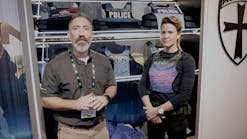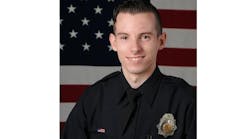I just taught a class at the enforcement Expo in Las Vegas on tactical fitness and injury prevention. The crux of the class was to get the officers to understand that there are a few things that must be understood when it comes to fitness and exercise. Without this understanding your risk of ineffective exercise and injury will continue to be very high. What I am referring to are two very predictable and preventable postural distortions that if left unrecognized will cause injury at some point in your career. On top of that these postural distortions will also effect how you move, and when applied to exercises it simply means that you will be working a lot harder than you have to while getting much less of the results that you desire. In previous columns I have discussed upper cross and lower cross postural patterns and we have examined how they contribute to injurious patterns and inefficient muscular firing in the body. Please reference those articles as I would like to take this column a bit farther this month.
During the enforcement expo class we discussed in depth the top 10 exercises that you just do not want to do. These exercises do more harm than good and their carryover into tactical situations are both limited and in many cases useless not to mention harmful. So here are the top 10 exercise that you just do not want to do.
10) Isolation training aka. Arms: We do nothing in isolation, especially when in a tactical situation. Unless you are rehabilitating an injury there is no reason to ever train your arms. In fact bicep curls and triceps extensions place a major nasty force on your joints and ligaments both above and below the muscle, couple that with poor posture from sitting all day which places additional negative forces on the shoulders and there is no merit to this exercise. Besides you get all the arm work necessary when training back and doing pressing movements.
9) Sitting to exercise: Think of it this way, you do not run, fight, arrest or do any other physical aspect of your job sitting down so do not train that way. ALL your exercises must be done standing, which means chest exercises should no longer be done sitting or lying down. Cable chest presses, standing shoulder presses, the list is endless.
8) Pushing more than you pull: Your body is made to be stronger pulling than pushing, look at kinesiology and there are no push actions in the body. A push movement is a series of levers and pulling movements. Besides we all sit too much so the muscles in the front of your body are already too tight. You should always do 2 pull exercises for every push.
7) Behind the Head: There is never a time in life where you need to push or pull anything behind your head, couple that with the extreme joint strain that your shoulders experience plus forcing your neck forward further reinforcing a forward head posture and I can think of no reason why these exercise should ever be done.
6) Smith Machine: Walk into any gym and many stations and the smith machine is loaded with weight. First of all life, especially law enforcement is never controlled and balanced so why train that way? Using this machine occasionally has it’s merits, I like to tether my resistance bands to it, but to do squats and presses on this machine forces you to move in unnatural patterns that place a lot of strain on the body. Plus the simple fact that if it’s too heavy forcing you to use a machine don’t use that much weight in the first place.
5) High pulls / front raises: Folks, the shoulder and neck is always under duress secondary to how much you sit, upper cross syndrome which we all have plus all the gear you have strapped to your person. Adding exercises that further compress the shoulder and strain the neck merely means you get hurt sooner. Pulling a bar up in front of your chin or raising a dumbbell out directly in front of you is killing your shoulders. Instead try dumbbell scaptions(V’s), prone shoulder presses on a ball or staggered stance pushups as they are all effective and better for you.
4) Leg raises: Many officers believe that leg raises of any fashion strengthen the abs but this is far from the truth. Sure you may feel it in your abs but these exercises actually over work your hip flexors and place significant compressive strain on your PSOAS which is a primary spine stabilizer. Since we all sit too much making the hip flexors tighter while compressing muscles that do not need compression means these exercises have little to no benefit.
3) Shrugs: This one is short and sweet, your traps are tight and cause a lot of the pain and dysfunction felt in the neck, shoulders and upper back. Do not do them, the traps get more then enough work on other exercises.
2) Back Extensions: Any prudent officer with a sore back wants to make it stronger so off to the gym you go and the first exercise chosen is the back extension which places 680lbs of compressive force on the spine PER REP! The key to a strong back is having flexible hip flexors and strong stable glutes. Your hips and gluteal muscles are the key to a strong back. Squats, step ups, bridges, lunges are all the keys to avoiding back injury while drastically improving tactical fitness.
1) Crunches: Last but definitely not least is the venerable crunch. This staple of abdominal training and spine wrecking puts 730lbs of force PER REP on each segment of the spine. 730 lbs is a NIOSH action point where all activity must stop but there you are banging out rep after rep with the ultimate result being tissue damage and failure. Instead do planks, lateral planks, core presses and prone reach exercises as they fire the entire abdominal wall safely and naturally. Strong abs means better core control and better balance and that translates into superb tactical fitness.
As I closed my class at the enforcement expo so I will close here with the knowledge that to be tactically fit means understanding what defeats us mechanically, remove those obstacles and you will be able to do all that you expect out of your body.
Web Links:
About The Author:
Bryan Fass is the author of “Fit Responder”, a comprehensive wellness plan for the first responder, and the Fit Responder Blog. Bryan has a Bachelor’s Degree in Sports Medicine and is certified as a licensed athletic trainer and a strength and conditioning specialist. He was a paramedic for over 8 years. Bryan has authored four books regarding fitness, wellness and human performance. Bryan is available for Consulting and Speaking on Public Safety Fitness Testing along with Fitness, Wellness and Injury Prevention Programs. Contact him via email to [email protected].

Bryan Fass
is a leading expert on public safety injury prevention. As the president and founder of Fit Responder Bryan’s company works nationally with departments, corporations; state and local governments to design and run targeted injury prevention and wellness programs. He is frequently contacted for expert opinion and content contribution for all aspects of public safety fitness, ergonomics and wellness. Bryan authored the Fit Responder book used by departments and schools plus writes for numerous web and peer-reviewed journals including the NSCA-Tactical Strength & Conditioning journal, officer.com, ems-1.com & best practices in EMS. Bryan holds a bachelors’ degree in sports medicine with over 17 years of clinical practice, was a paramedic for over 8 years, and is certified as an Athletic Trainer (ATC, LAT), Strength Coach (CSCS) and the Functional Movement Screen (FMS). Fit Responder developed the nation’s first validated pre-hire Physical Abilities Test for EMS. Bryan is a sought-after speaker on a variety of topics including risk reduction, employee self-care, real world wellness and How to Eat on the street. www.fitresponder.com
Every Lift Counts!


